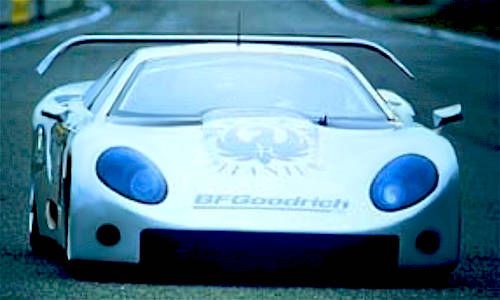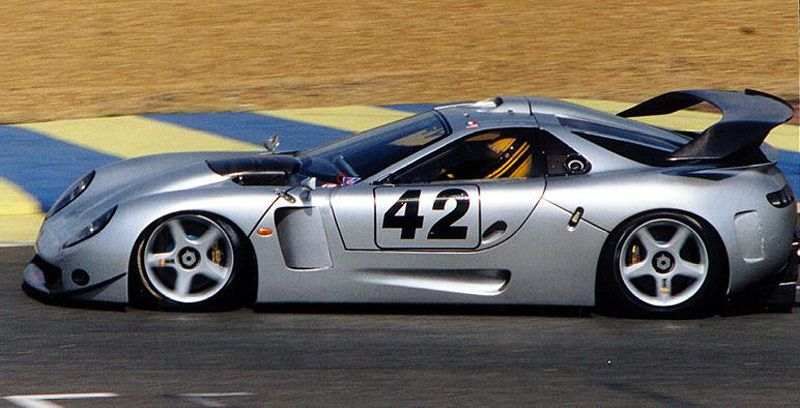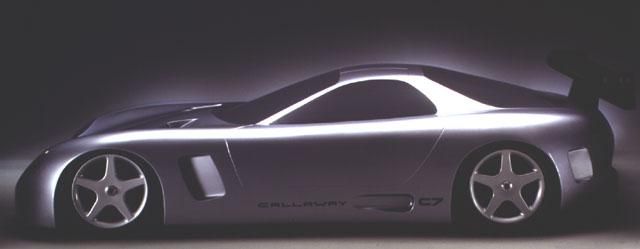The Callaway C7 is a car that was the product of a very specific period in the history of the FIA. Just as the '80s had seen the emergence of the Group B racer, the '90s had the GT1 endurance racer, a very rare sort of a car that pushed the limits of what you could call a production car just as far as they would go. Few companies would even attempt to build one, and these were mostly bigger companies like Porsche and Mercedes-Benz. But Callaway Cars->ke19 of Old Lyme, Connecticut took a shot at one as well.
The name of the car is slightly confusing, especially since there is currently a Callaway-tuned version of the C7 Corvette sold as a GT3-R, and commonly referred to as the Callaway C7. Callaway projects are also named with a “C” followed by a number, and this one is number 7. It wasn’t quite so confusing when the project started and Chevrolet->ke199 was still building the C4 Corvette. Callaway is a tuning company that works with a lot of different brands, but made its name with hugely powerful Corvettes. The C7 is loosely connected to the Corvette,->ke1280 but couldn't really be said to be based on the Chevrolet.
Continue reading to learn more about the Callaway C7 Corvette.
1997 Callaway C7 Corvette
- Make: Array
- Model: 1997 Callaway C7 Corvette
- [do not use] Vehicle Model: Array
Exterior
GT1 cars fell into one of two categories when it came to styling. First, there were the cars like the Porsche 911 GT1, which in spite of its name had almost nothing in common with anything else called a 911. But it was still styled to look as much like a 911 as possible, most likely to give the 911 line a boost in track credibility. The other category is exemplified by the Toyota GT-One, a car that is essentially a prototype racer even in appearance. GT1 did require homologation, but in such small quantities that beyond being road legal, no concessions really had to be made in the name of practicality.
So the C7 looks like a race car, because that was all it was really intended to be. But the styling doesn't really fit into either of the usual GT1 categories. It does look as though its based on a road car, but no road-going version existed, so the body shape is still technically a prototype. It's an odd approach, but the car does have a certain mid-'90s aesthetic appeal. The body is made of carbon fiber as well, a much bigger deal in 1996/1997 than it is today.
Interior
Obviously, since the C7 was built to race, there isn't any sort of an interior to speak of, just a lot of bare carbon fiber. There is a second seat though, sort of the closest that the car gets to an optional extra. We're all free to speculate what the interior would have been like if the C7 had lasted in motorsports long enough that Callaway had started taking the homologation requirements seriously and actually built some road-going versions. But unfortunately that never happened, and the only units actually built were made for racing.
Drivetrain
The engine is the C7 is a heavily modified version of the LT5 out of the then-current ZR-1 Corvette. The engine had been first appropriated by Callaway for use in the Company's SuperNatural Corvette, where it was available with up to 475 horsepower. For the C7, power was cranked up to 680 horsepower by way of a supercharger. The 6.3-liter V-8 engine was mid-front mounted, hence the extremely long hood, with a rear-mounted transaxle for an even weight distribution. All of the carbon fiber made the car very light, at less than 2,500 pounds. This meant a power to weight ratio of 3.6 pounds per horsepower, among the best to date of any car that was theoretically road legal.
Prices
Just two C7s were ever built. More would have been required, although not by much, had the racing program been a success, but it never really got off the ground. The C7 failed to qualify at the 1996 24 Hours of Le Mans, but actually did race at the 1997 Daytona Rolex 24 Hours. That is, it raced half of Daytona before an oil system failure knocked it out of the race. The car had led the race up until that point, but the program still ended after Daytona, and production stopped at 2 units. One of these currently belongs to the founder/owner of Callaway, Reeves Callaway. The other one is theoretically on the market, but at the Kissimmee auction in 2014, it failed to reach its reserve of $150,000 and wasn't sold. So the value is presumably somewhere below that, difficult as that might be to believe.
Competition
Porsche 911 GT1
Not really a 911 in most respects, the did use a highly modified flat-6 engine and the front chassis of the Type 993 911. Some versions would also share the Type 996's “fried egg” headlights, although that isn't a great thing to share. Otherwise, the mid-engine car was all racer, and it won its class in its first race, the 1996 24 Hours of Le Mans, and it would win outright in 1998. Porsche was also diligent about making road-going homologation specials, of which 25 were built.
Read our full review on the Porsche 911 GT1 here.
McLaren F1 GTR
The F1 GTR was the first GT1 car to score an overall win at Le Mans in 1995. The F1 is the stuff of legends, and at the time, the road-going version of the car was the fastest production car in the world. 71 road cars were built, as well as 28 of the F1 GTR race cars. All are extremely valuable, and one recently sold for over $8 million.
Read our full review on the McLaren F1 GTR here.
Conclusion
The C7 was a really valiant effort at a race car. It began development all of the way back in 1993, the year that GT1 started up. It took three years for this small company to take it to its first race, but it was able to run with the best of them at Daytona. It's true that GT1 ended just one year after the C7 was retired, so it probably wouldn't have had too illustrious a history no matter what, but it will always seem like a shame that Callaway was either unwilling or unable to take the project any further.









